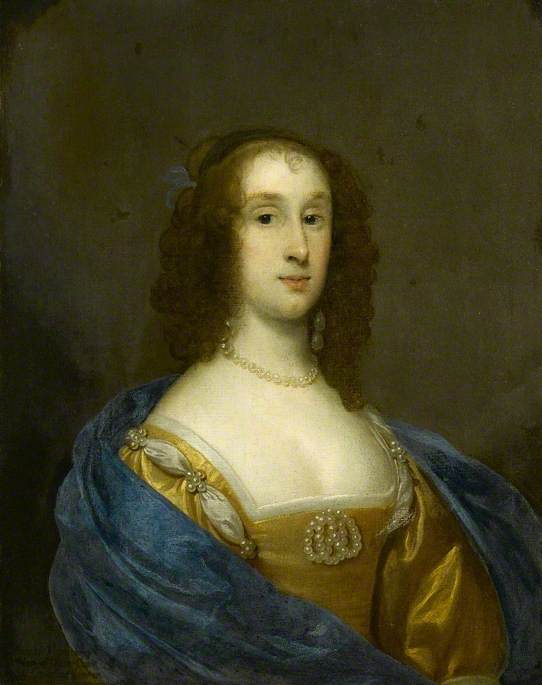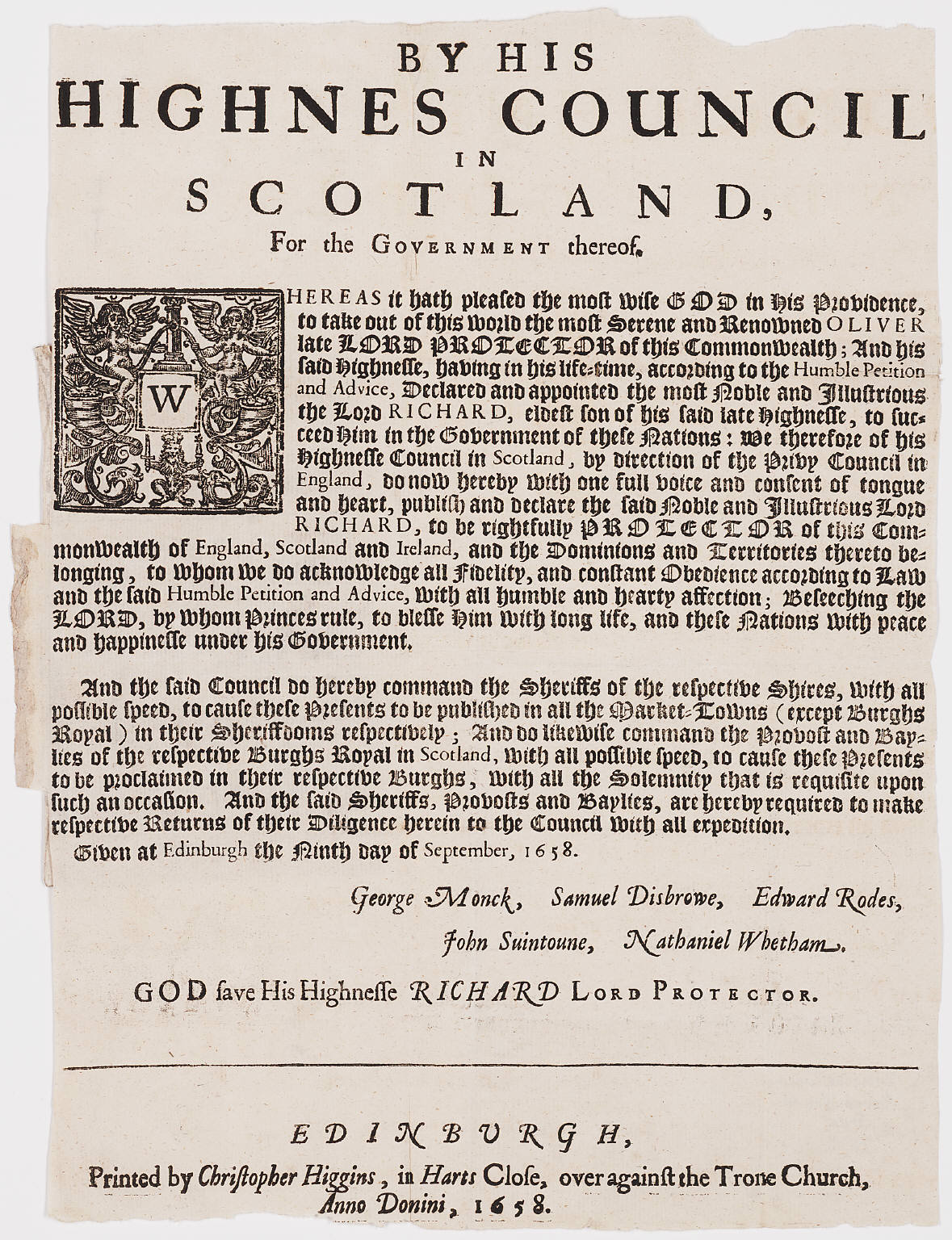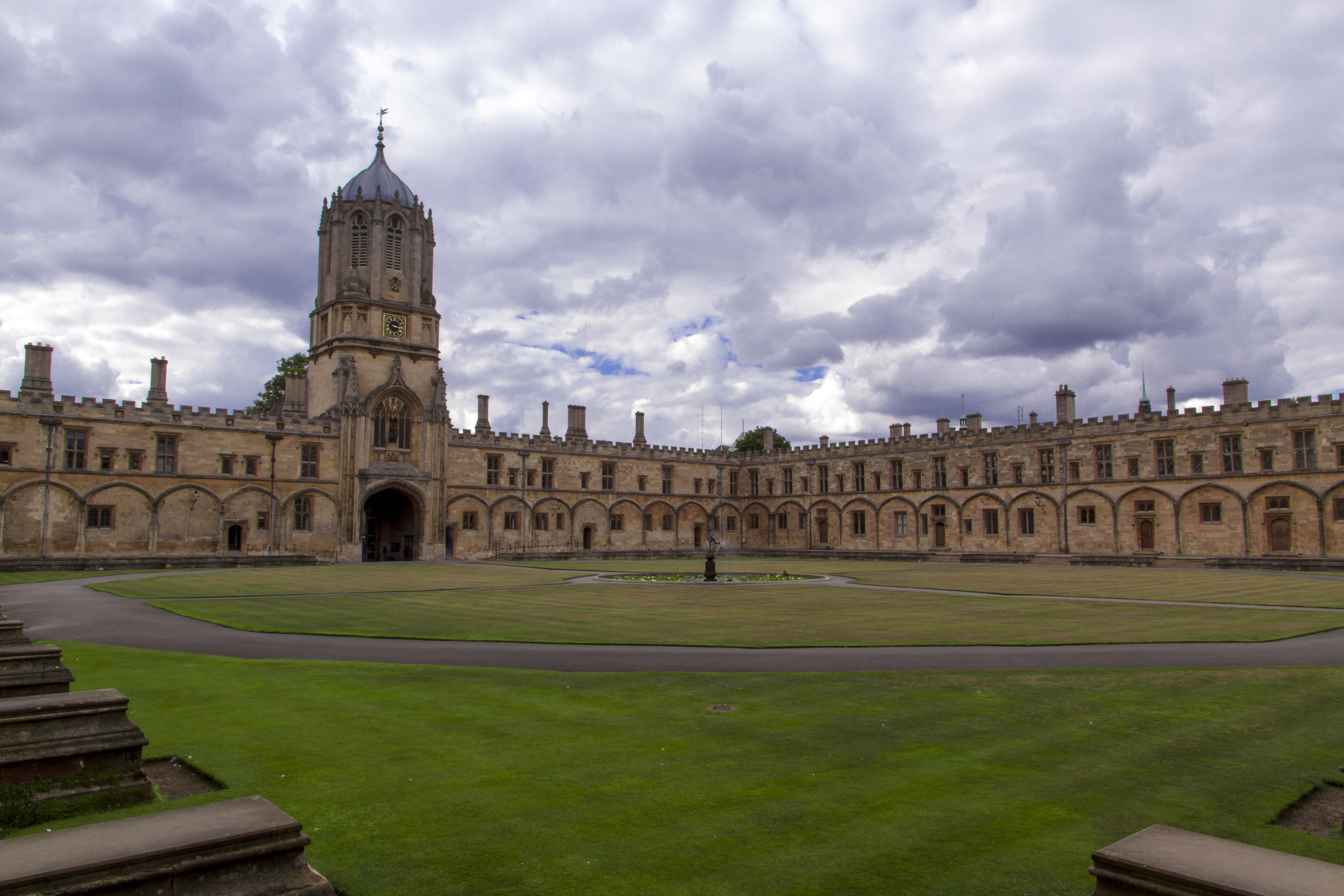|
Charles Fleetwood
Charles Fleetwood (c. 1618 – 4 October 1692) was an English Parliamentarian soldier and politician, Lord Deputy of Ireland in 1652–1655, where he enforced the Cromwellian Settlement. Named Cromwell's Lieutenant General for the Third English Civil War, Fleetwood was thereafter one of his most loyal supporters throughout the Protectorate. After the Lord Protector's death, Fleetwood was initially supportive of his brother-in-law Richard Cromwell, but turned against him and forced him from power. Together with his colleague John Lambert he dominated government for a little over a year before being outmaneuvered by George Monck. At the Restoration he was included in the Act of Indemnity as among the twenty liable to penalties other than capital, and was finally incapacitated from holding any office of trust. His public career then closed. Early life Charles Fleetwood was the third son of Sir Miles Fleetwood of Aldwinkle, Northamptonshire, and of Anne, daughter of Nicholas Lu ... [...More Info...] [...Related Items...] OR: [Wikipedia] [Google] [Baidu] |
Robert Walker (painter)
Robert Walker (1599–1658) was an English portrait painter, notable for his portraits of the " Lord Protector" Oliver Cromwell and other distinguished parliamentarians of the period. He was influenced by Van Dyck, and many of his paintings can now be found at the National Portrait Gallery, London. Life and work Walker was the chief painter of the parliamentary party during the Commonwealth of England from 1649 to 1660. Nothing is known of his early life. His manner of painting, though strongly influenced by that of Van Dyck, is yet distinctive enough to rule out the possibility of him being one of Van Dyck's immediate pupils. He is chiefly known for his portraits of Oliver Cromwell, and our knowledge of Cromwell's appearance is mainly based on Walker's paintings, as well as the portraits of him by Samuel Cooper and by Peter Lely. There are two main types. The earlier, representing Cromwell in armour with a page tying on his sash, and the later, full face to the waist in ar ... [...More Info...] [...Related Items...] OR: [Wikipedia] [Google] [Baidu] |
Siege Of York
The siege of York in 1644 was a prolonged contest for York during the First English Civil War, between the Scottish Covenanter army and the Parliamentarian armies of the Northern Association and Eastern Association, and the Royalist Army under the Marquess of Newcastle. It lasted from 22 April until 1 July when the city was relieved by Prince Rupert of the Rhine. Rupert and Newcastle were defeated the next day at the decisive Battle of Marston Moor, and the siege resumed until the city was surrendered on easy terms on 16 July. Campaign Early years of the Civil War During the 17th century, York was often referred to as the "capital of the north" and sometimes as the "second city in England" (although Bristol had a larger population). It had great prestige as the seat of the Archbishop of York, and as the centre of much of the region's trade. When civil war broke out in 1642, the Royalists in Yorkshire were briefly besieged in the city, until the Earl of Newcastle ... [...More Info...] [...Related Items...] OR: [Wikipedia] [Google] [Baidu] |
John Lambert (General)
John Lambert, also spelt 'Lambart' (7 September 1619 – 1 March 1684) was an English Parliamentarian general and politician. Widely regarded as one of the most talented soldiers of the period, he fought throughout the Wars of the Three Kingdoms, and was largely responsible for victory in the 1650 to 1651 Scottish campaign. Although involved in the discussions between the New Model Army and Parliament during 1647, his first formal involvement in civilian politics was in 1653 when he became a member of the English Council of State. In December 1653, he helped prepare the ' Instrument of Government', which provided the constitutional framework for the Protectorate. He later fell out with Oliver Cromwell, largely because he opposed converting his role as Lord Protector into a kingship. He lost his offices in 1657 after refusing to swear an oath of loyalty to Cromwell, and after Cromwell's death in September 1658, he re-entered politics as Member of Parliament for Pontefract i ... [...More Info...] [...Related Items...] OR: [Wikipedia] [Google] [Baidu] |
Richard Cromwell
Richard Cromwell (4 October 162612 July 1712) was an English statesman who was the second and last Lord Protector of the Commonwealth of England, Scotland and Ireland and son of the first Lord Protector, Oliver Cromwell. On his father's death in 1658 Richard became Lord Protector, but lacked authority. He tried to mediate between the army and civil society and allowed a Parliament containing many disaffected Presbyterians and Royalists to sit. Suspicions that civilian councillors were intent on supplanting the army were brought to a head by an attempt to prosecute a major-general for actions against a Royalist. The army made a threatening show of force against Richard and may have had him in detention. He formally renounced power nine months after succeeding. Although a Royalist revolt was crushed by the recalled civil war figure General John Lambert, who then prevented the Rump Parliament from reconvening and created a Committee of Safety, Lambert found his troops melted away ... [...More Info...] [...Related Items...] OR: [Wikipedia] [Google] [Baidu] |
Third English Civil War
Third or 3rd may refer to: Numbers * 3rd, the ordinal form of the cardinal number 3 * , a fraction of one third * 1⁄60 of a ''second'', or 1⁄3600 of a ''minute'' Places * 3rd Street (other) * Third Avenue (other) * Highway 3 Music Music theory * Interval number of three in a musical interval **major third, a third spanning four semitones **minor third, a third encompassing three half steps, or semitones ** neutral third, wider than a minor third but narrower than a major third ** augmented third, an interval of five semitones ** diminished third, produced by narrowing a minor third by a chromatic semitone * Third (chord), chord member a third above the root * Degree (music), three away from tonic ** mediant, third degree of the diatonic scale **submediant, sixth degree of the diatonic scale – three steps below the tonic ** chromatic mediant, chromatic relationship by thirds *Ladder of thirds, similar to the circle of fifths Albums *'' Third/Sister L ... [...More Info...] [...Related Items...] OR: [Wikipedia] [Google] [Baidu] |
Roundhead
Roundheads were the supporters of the Parliament of England during the English Civil War (1642–1651). Also known as Parliamentarians, they fought against King Charles I of England and his supporters, known as the Cavaliers or Royalists, who claimed rule by absolute monarchy and the principle of the divine right of kings. The goal of the Roundheads was to give to Parliament the supreme control over executive branch, executive administration of the country/kingdom. Beliefs Most Roundheads sought constitutional monarchy in place of the absolute monarchy sought by Charles; however, at the end of the English Civil War in 1649, public antipathy towards the king was high enough to allow republican leaders such as Oliver Cromwell to abolish the monarchy completely and establish the Commonwealth of England. The Roundhead commander-in-chief of the first Civil War, Thomas Fairfax, remained a supporter of constitutional monarchy, as did many other Roundhead leaders such as Edward Monta ... [...More Info...] [...Related Items...] OR: [Wikipedia] [Google] [Baidu] |
England
England is a country that is part of the United Kingdom. It shares land borders with Wales to its west and Scotland to its north. The Irish Sea lies northwest and the Celtic Sea to the southwest. It is separated from continental Europe by the North Sea to the east and the English Channel to the south. The country covers five-eighths of the island of Great Britain, which lies in the North Atlantic, and includes over 100 smaller islands, such as the Isles of Scilly and the Isle of Wight. The area now called England was first inhabited by modern humans during the Upper Paleolithic period, but takes its name from the Angles, a Germanic tribe deriving its name from the Anglia peninsula, who settled during the 5th and 6th centuries. England became a unified state in the 10th century and has had a significant cultural and legal impact on the wider world since the Age of Discovery, which began during the 15th century. The English language, the Anglican Church, and Eng ... [...More Info...] [...Related Items...] OR: [Wikipedia] [Google] [Baidu] |
Battle Of Worcester
The Battle of Worcester took place on 3 September 1651 in and around the city of Worcester, England and was the last major battle of the 1639 to 1653 Wars of the Three Kingdoms. A Parliamentarian army of around 28,000 under Oliver Cromwell defeated a largely Scottish Royalist force of 16,000 led by Charles II of England. The Royalists took up defensive positions in and around the city of Worcester. The area of the battle was bisected by the River Severn, with the River Teme forming an additional obstacle to the south-west of Worcester. Cromwell divided his army into two main sections, divided by the Severn, in order to attack from both the east and south-west. There was fierce fighting at river crossing points and two dangerous sorties by the Royalists against the eastern Parliamentary force were beaten back. Following the storming of a major redoubt to the east of the city, the Parliamentarians entered Worcester and organised Royalist resistance collapsed. Charles II was abl ... [...More Info...] [...Related Items...] OR: [Wikipedia] [Google] [Baidu] |
Battle Of Dunbar (1650)
The Battle of Dunbar was fought between the English New Model Army, under Oliver Cromwell and a Scottish army commanded by David Leslie, on 3 September 1650 near Dunbar, Scotland. The battle resulted in a decisive victory for the English. It was the first major battle of the 1650 invasion of Scotland, which was triggered by Scotland's acceptance of Charles II as king of Britain after the beheading of his father, Charles I on 30 January 1649. After Charles I's execution, the English Rump Parliament established a republican Commonwealth in England. When their erstwhile ally, Scotland, recognised Charles II as king of all of Britain on 1 May 1650 and began recruiting an army to support him, the English dispatched the New Model Army, under the command of Cromwell. The army crossed into Scotland on 22 July, with a force of over 16,000 men. The Scots withdrew to Edinburgh, stripping the land of provisions. Cromwell attempted to draw the Scots out into a set piece battle ... [...More Info...] [...Related Items...] OR: [Wikipedia] [Google] [Baidu] |
Siege Of Oxford
The siege of Oxford comprised the English Civil War military campaigns waged to besiege the Royalist controlled city of Oxford, involving three short engagements over twenty-five months, which ended with a Parliamentarian victory in June 1646. The first engagement was in May 1644, during which King Charles I escaped, thus preventing a formal siege. The second, in May 1645, had barely started when Sir Thomas Fairfax was given orders to stop and pursue the King to Naseby instead. The last siege began in May 1646 and was a formal siege of two months; but the war was obviously over and negotiation, rather than fighting, took precedence. Being careful not to inflict too much damage on the city, Fairfax even sent in food to the King's second son, James, and was happy to conclude the siege with an honourable agreement before any further escalation occurred. Oxford during the civil war The creation of the King's Oxford Parliament in January 1644 placed Oxford at the cen ... [...More Info...] [...Related Items...] OR: [Wikipedia] [Google] [Baidu] |
Siege Of Basing House
The siege of Basing House near Basingstoke in Hampshire, was a Parliamentarian victory late in the First English Civil War. Whereas the title of the event may suggest a single siege, there were in fact three major engagements. John Paulet, 5th Marquess of Winchester owned the House and as a committed Royalist garrisoned it in support of King Charles I, as it commanded the road from London to the west through Salisbury. The first engagement was in November 1643, when Sir William Waller at the head of an army of about 7,000 attempted to take Basing House by direct assault. After three failed attempts it became obvious to him that his troops lacked the necessary resolve, and with winter fast approaching Waller retreated back to a more friendly location. Early in 1644 the Parliamentarians attempted to arrange the secret surrender of Basing House with Lord Edward Paulet, the Marquess of Winchester's younger brother, but the plot was discovered. Parliamentary forces cont ... [...More Info...] [...Related Items...] OR: [Wikipedia] [Google] [Baidu] |
Siege Of Bristol (1645)
The Second Siege of Bristol of the First English Civil War lasted from 23 August 1645 until 10 September 1645, when the Royalist commander Prince Rupert surrendered the city that he had captured from the Parliamentarians on 26 July 1643. The commander of the Parliamentarian New Model Army forces besieging Bristol was Lord Fairfax. Prelude After reducing Bridgwater Fairfax and the New Model Army turned back to clear away the Dorsetshire Clubmen and besiege Sherborne Castle. On the completion of this task, it was decided to besiege Bristol. Siege On 23 August 1645 the New Model Army invested Bristol. On the night of 9/10 September, Fairfax's army stormed Bristol. Prince Rupert had long realised the hopelessness of further fighting. The lines of defence around the place were too extensive for Prince Rupert's small force and on 10 September he surrendered Bristol on terms. Prince Rupert was escorted to Oxford with his men, conversing as he rode with the officers of the es ... [...More Info...] [...Related Items...] OR: [Wikipedia] [Google] [Baidu] |


_by_Robert_Walker_and_studio.jpg)






